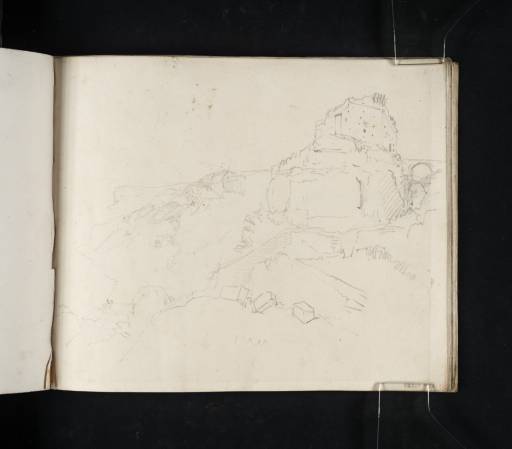Joseph Mallord William Turner Bow and Arrow or Rufus Castle, Portland 1811
Image 1 of 2
Joseph Mallord William Turner,
Bow and Arrow or Rufus Castle, Portland
1811
Joseph Mallord William Turner 1775–1851
Folio 26 Recto:
Bow and Arrow or Rufus Castle, Portland 1811
D08837
Turner Bequest CXXIV 26
Turner Bequest CXXIV 26
Pencil on white wove paper, 170 x 209 mm
Blind-stamped with Turner Bequest monogram bottom right
Stamped in black ‘CXXIV – 26’ bottom right
Blind-stamped with Turner Bequest monogram bottom right
Stamped in black ‘CXXIV – 26’ bottom right
Accepted by the nation as part of the Turner Bequest 1856
References
1909
A.J. Finberg, A Complete Inventory of the Drawings of the Turner Bequest, London 1909, vol.I, p.354, CXXIV 26, as ‘Bow and Arrow Castle, Isle of Portland’.
1981
Eric Shanes, Turner’s Rivers, Harbours and Coasts, London 1981, p.152.
1990
Frank Milner, J.M.W. Turner: Paintings in Merseyside Collections: Walker Art Gallery; Sudley Art Gallery; Williamson Art Gallery; Lady Lever Art Gallery; Liverpool University Art Gallery, Liverpool 1990, p.36 under no.18, reproduced p.37.
1992
Howard J.M. Hanley, Turner in Dorset: Images from the Picturesque Views on the Southern Coast of England, exhibition catalogue, Mulberry Gallery, Weymouth Library 1992, p.29 no.51, reproduced.
Bow and Arrow Castle is also known as Rufus Castle, apparently by association with the Norman King William II (William ‘Rufus’, 1087–1100). It stands above Church Ope Cove on the south-eastern side of the Isle of Portland and is here seen from the north-east. Turner’s viewpoint is accessible from the lane by the Portland Museum off Wakeham Street, Easton, via a footpath through the archway on the right. In an rare revision, Turner has drawn the arch twice, the upper version giving it rather more prominence than in reality. At the time of his visit the foreground was a quarry.
Finberg notes that this sketch and that on folio 27 recto (D08838) are the sources for the watercolour Bow and Arrow Castle, Isle of Portland of about 1815 (University of Liverpool),1 engraved in 1817 for the Picturesque Views on the Southern Coast of England2 (see the concordance of the series in the 1811 tour introduction). The composition is largely based on the present drawing, with its dramatic, steep view up from the castle’s setting of solid rock with a prominent vertical fissure to the massive corbels which still survive on its roofline. The mock-medieval Pennsylvania Castle, recorded in the sketch made on folio 27 recto from further back and higher up, is included in the watercolour, where it is just visible through and above the archway; Turner also introduced numerous quarrymen working in the foreground. He wrote of the Portland quarries in verse in the Devonshire Coast, No.1 sketchbook (Tate D08484; Turner Bequest CXXIII 61).
Technical notes:
There is some rubbing or spotting from the centre of the drawing upwards. The sheet is slightly darkened from prolonged display; the edges are unaffected, having been protected by a display mount.
Verso:
Blank, save for inscriptions by John Ruskin in red ink ‘23’ bottom left and ‘636’ top right, both upside down.
Matthew Imms
February 2011
How to cite
Matthew Imms, ‘Bow and Arrow or Rufus Castle, Portland 1811 by Joseph Mallord William Turner’, catalogue entry, February 2011, in David Blayney Brown (ed.), J.M.W. Turner: Sketchbooks, Drawings and Watercolours, Tate Research Publication, December 2012, https://www


